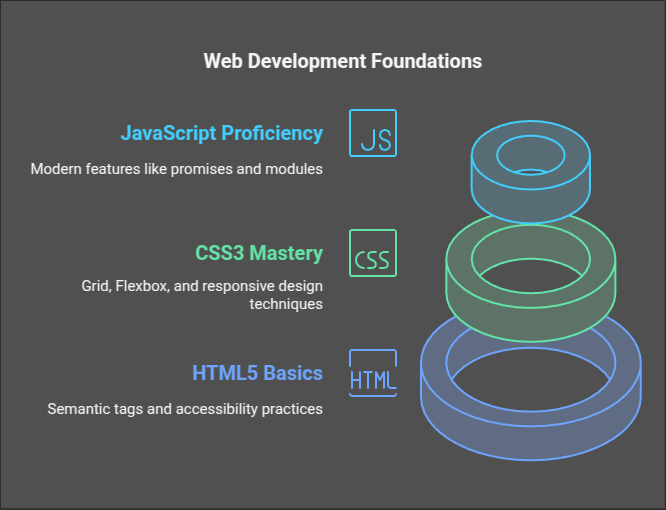This roadmap outlines the essential skills and resources for frontend developers aiming to thrive in the dynamic landscape of 2025. The rapid evolution of the IT sector, fueled by AI advancements and innovative tools, necessitates continuous learning and adaptation.
-
Mastering the Fundamentals

Begin with a solid understanding of core web technologies:
-
HTML5: Focus on semantic markup, accessibility (ARIA attributes), and SEO best practices.
-
CSS3: Become proficient in Grid, Flexbox, animations, pseudo-selectors, CSS variables, and responsive design principles.
-
JavaScript (ES6 ): Learn modern JavaScript features including
let, const, arrow functions, destructuring, modules, promises, async/await, and more.
-
Essential Frontend Development Expertise

Success in 2025 requires proficiency in:
-
Version Control (Git): Utilize Git and platforms like GitHub, GitLab, or Bitbucket for collaborative coding and version management.
-
CSS Frameworks: Master popular frameworks such as Tailwind CSS (a leading choice in 2025) or Bootstrap for efficient styling.
-
JavaScript Frameworks: Gain expertise in at least one major framework:
-
React.js: Remains highly prevalent, backed by a strong community.
-
Next.js: Favored for its server-side rendering (SSR), server components, and seamless AI integration.
-
Angular: Well-suited for enterprise applications and integrates well with RxJS.
-
Vue.js 3 : Known for its lightweight nature and ease of use for beginners.
-
State Management: Learn effective state management techniques:
-
React: Redux Toolkit, Zustand, or the React Context API.
-
Angular: NgRx.
-
Leveraging AI-Powered Frontend Tools

AI is transforming frontend development. Embrace these tools:
-
AI Coding Assistants: Utilize tools like GitHub Copilot, Codeium, or ChatGPT for VS Code to accelerate code development.
-
AI Design Tools: Employ Figma AI for rapid UI component and layout generation.
-
AI Testing Tools: Explore AI plugins for Cypress or TestGPT to automate testing processes.
-
AI APIs: Integrate APIs from OpenAI or Hugging Face to incorporate features like chatbots, AI-driven content generation, or personalized recommendations.
-
Advanced Frontend Techniques

Elevate your skills by mastering:
-
TypeScript: Essential for building scalable and maintainable applications.
-
Testing Frameworks: Become proficient in unit testing (Jest, Mocha), component testing (React Testing Library, Vue Test Utils), and end-to-end testing (Cypress, Playwright).
-
Performance Optimization: Learn techniques like code splitting, lazy loading, and the strategic use of SSR/CSR. Utilize AI-powered tools for image optimization.
-
Design Systems: Learn to use and create design systems such as Material UI, Chakra UI, or custom-built libraries.
-
Exploring Next-Generation Technologies

Stay ahead of the curve by exploring:
-
Edge Computing: Deploy applications on platforms like Vercel, Netlify, or Cloudflare.
-
Server Components (React): Master React Server Components for optimized server-side rendering.
-
Streaming Data: Build real-time applications using WebSockets or Server-Sent Events (SSE) and leverage AI for efficient live data processing.
-
AI-Enhanced UI/UX Design

Modern frontend developers need strong UI/UX skills:
-
Design Tools: Master Figma (with its AI capabilities) or Sketch for creating user-friendly interfaces.
-
Accessibility: Build WCAG-compliant interfaces and leverage AI tools for accessibility audits.
-
Motion Design: Utilize tools like GSAP or AI-powered animation generators for engaging interactive designs.
-
Integrating AI and Machine Learning

Learn to integrate AI and ML into your projects:
-
AI-Powered Features: Embed chatbots, recommendation engines, and AI-generated content into your applications.
-
ML Libraries: Explore TensorFlow.js, Brain.js, or ml5.js for incorporating machine learning into frontend applications. ml5.js, in particular, offers readily accessible pre-trained models for tasks such as image recognition and sentiment analysis.
-
AI Workflow Automation: Use APIs to automate tasks and enhance user experience.
Pre-trained Model Resources: ml5.js, TensorFlow.js Models, Hugging Face, Teachable Machine.
-
Backend for Frontend (BFF)

Expand your skillset with basic backend knowledge:
-
Node.js: Build APIs and manage server-side logic using frameworks like Express or NestJS.
-
Database Management: Learn NoSQL databases (MongoDB, Firebase) and SQL databases (PostgreSQL, Supabase).
-
API Integration: Gain experience working with REST, GraphQL, and WebSockets.
-
CI/CD and Deployment

Streamline your workflow with:
-
CI/CD Tools: Utilize GitHub Actions, Jenkins, or AI-enhanced platforms like Harness.
-
Hosting Platforms: Deploy applications on Vercel, Netlify, AWS Amplify, or Azure Static Web Apps.
-
Essential Soft Skills
Develop strong soft skills:
- Stay updated on industry trends (consider AI-powered newsletters).
- Collaborate effectively using tools like Notion, Slack, or Miro.
- Contribute to open-source projects and document your work professionally.
Optional Emerging Areas: Web3 (Ethers.js), 3D/WebGL (Three.js), Voice & Gesture Control (Web Speech API).
Conclusion: The future of frontend development is a blend of traditional expertise and cutting-edge AI tools. By following this roadmap, you can position yourself for success in this rapidly evolving field. Embrace the AI revolution, stay curious, and continue learning!
The above is the detailed content of The Ultimate Frontend Developer Roadmap for 5. For more information, please follow other related articles on the PHP Chinese website!














